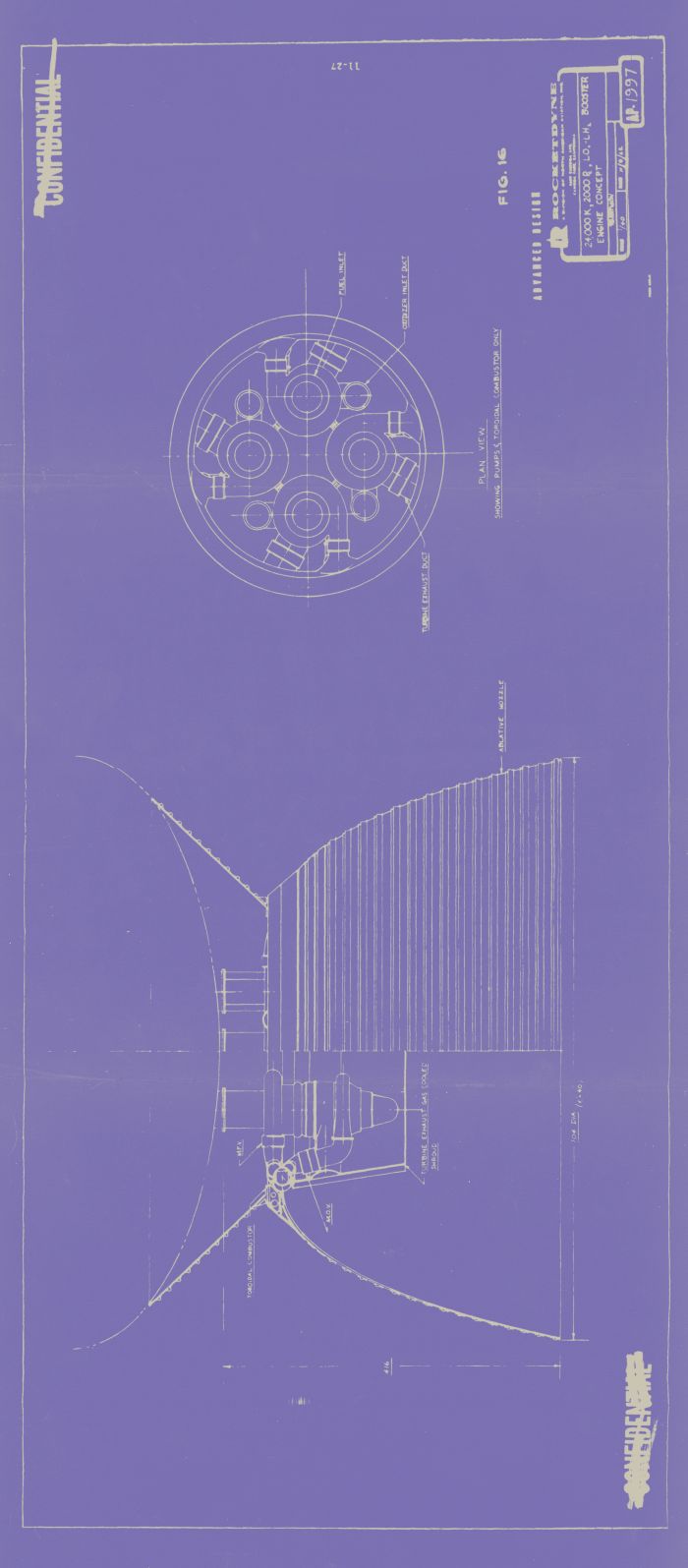Jun 292010
Now we’re talkin’. None of that namby-pamby six million pound thrust childs play anymore; a rocket engine that a man can respect.
The L-24 AH used four of the turbopumps used by the individual 6-million pound thrust L-6H hydrogen/oxygen engines. Chamber pressure was 2000 psi and the expansion ratio was 40. This engine used a toroidal combustion chamber wrapped around a central “plug,” much like an aerospike engine, but with an external bell wrapped around everything.
11 Responses to “Rocketdyne 24 Million Pound Thrust Rocket Engine”
Sorry, the comment form is closed at this time.

Can you imagine the acoustic output of that thing firing?
Even the test stand for it would be a real challenge to design.
If you fired it in normal launch orientation, the whole test stand might tear free from the ground and lift off.
Any idea about what they thought they actually needed this thing for?
It’s like something you would use to launch solar power satellites with.
Now that’s one weird-ass nozzle. I assume the external nozzle has the same contour as an expansion-deflection nozzle.
Aerojet had a 24 million pound design, but it had 12 or 24 normal thrust chambers dumping into a single nozzle, which is probably only a 6 on the Scott Lowther Badass Scale. Toroidal combustion chamber? Sweet.
> Any idea about what they thought they actually needed this thing for?
It’s a smaller version of an engine that they thought might be nice in a cluster for sizable launchers.
This is the small one?? And they were clustered? How many?
> This is the small one?
Yes.
> And they were clustered?
Well, no. My recently-fever-wracked memory failed me. The Nexus could use *one* of the larger engines, or a dozen or so smaller engines of the same type shown, or a bunch of conventional bell engines clustered around a plug (what’s most commonly shown). The 30,000,000-lb-thrust engine was 150 feet in diameter and itself weighed in at a 1.3Mpounds, due to having an ablative bell rather than regen cooling.
Some of General Dynamics’ Post-Saturn “Class III” artwork (as opposed to purely NEXUS representations) shows the first stage of a 1.5 or 2 stage launcher with a giant nozzle, so this must be along the lines of what they had in mind.
150 ft. diameter? Cue “Song 2”.
And then there’s that nuclear thing on the back of the Aldebaran spacecraft:
http://1.bp.blogspot.com/_F4jAGNZC1cg/S5Y1KhPKCuI/AAAAAAAAADE/JAEZRHI3zTw/s1600-h/aldebaran2.jpg
It would be fun to get a view of it showing what exactly is inside of that nozzle.
back to Noise problem
with thrust up to 30,000,000-lb
not only everybody get deaf in radus of 15 miles of firing Engine
but noise it self make allot destuction on launch pad and on rocket
(like Shuttle soild booster or Sonic cut on Titan II engine)
had they solve that problem ? ? ?
Many of the Novas were intended to be launched on offshore platforms on the continental shelf. So, they’d be far enough away to avoid damage to unprotected people and buildings on land, whether a nominal launch or an unsuccessful one. However, maintaining land-based platforms in the Florida climate is challenging, so putting them at sea would have required even greater resources to be devoted to launch complex maintenance.
There were also plans to put launch pads north of LC 39 along and north of Playalinda Beach, in what is now the National Seashore. Even if it were legal to do that today, the growth in population directly west of the Seashore wouldn’t allow the proper separation distance.
LC39 is at the widest point of the “Cape” and thus has the best east-west separation distance.
Correction, Merritt Island, not Cape Canaveral.
NASA actually bought the land for the Nova pads, and I imagine that’s one reason it got turned into the National Seashore so easily rather than being used for commercial or tourist development.
Once you get up to this size of a launch vehicle, offshore launching starts to look like a really good idea not only from a noise point of view, but also the havoc the thing could wreak if it fell back on or near the pad on liftoff like the second N-1 did.